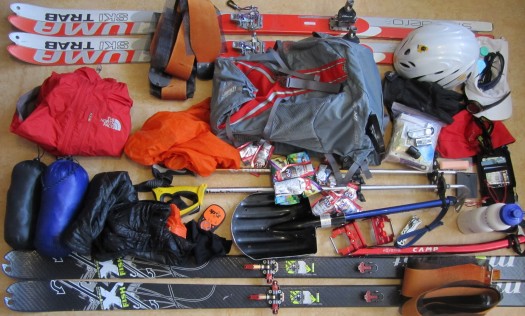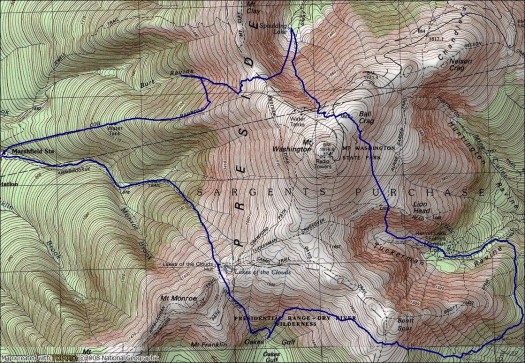So what is in your backcountry skiing pack? Or rather, what’s in my pack? And what about the relative weight split among different items?
Lou’s post on his springtime pack got me thinking. Especially thinking that my gear must be way lighter than this! Well, yes and no: my individual items are frequently lighter, but in my calcs I count more items.

A wee bit more convenient to carry all this in your pack, attached to your feet, and worn on your body!
How so? First off, the springtime skiing in New Hampshire’s Presidentials Range inevitably entails steep ascents that are firm enough to require various pointy implements. (Ditto for the typical late-spring and early-summer Pacific Northwest skiing with which I close out my season.) So even the lightest ski crampons, boot crampons, ice axe, and ski pole self-arrest grip still add up to a couple pounds of extra heft. Plus I feel a helmet is essential.
Second, and more importantly, the majority of my pack weight comprises emergency/back-up items, almost all of which I have never used on any spring or summer tour. That even includes the clothing I bring: Except for the waterproof shell during the occasional shower, and the insulating layers when my partners wanted to nap on Rainier’s summit, all I ever wear is my 2.1-ounce windshirt and (more rarely) 5.1-ounce vest. But if I should somehow have to stay put for more than a minute or so, my temperature drops rapidly from inactivity.
So insulation layers, back-up gloves, extra sunglasses, additional first-aid supplies, repair items, etc., do I really need all that for my style of backcountry skiing? The way I formulate the question for myself before each trip is, if I go on 100 such trips, and need the item only the 100th trip, will I be grateful enough to have that item on the 100th trip such that I won’t have minded schlepping it along on the other 99 trips? For shorter outings with a readily available exit back to the car, I go much lighter than this. But on longer outings with portions on the “wrong” side of the mountain from where I started as well as descents into essentially exit-less ravines, I’d feel like I was without the proverbial net if I left any of this behind.
| 142.8 | Skis, skins, poles |
| 102.9 | Lighter variation |
| 26.3 | BD Traverse adjustable poles w/ Grivel Condor self-arrest grip |
| 99.6 | Trab Duo Sint Aero skis + Dynafit Speed bindings + custom leash |
| 16.9 | Ascension nylon skins |
| 60.9 | or: Movement Fish-X skis + Plum 135 race bindings (w/ crampon catches) |
| 15.7 | Ascension nylon skins |
| 212.8 | In pack |
| 109.1 | Emergency/Back-Up portion of above |
| 37.0 | Dynafit Manaslu 28L pack |
| 7.4 | Garmin 60Cx GPS (w/ lanyard + Li batteries + pouch for carry shoulder strap) |
| 21.3 | 11x Gu + 4x Odwalla (portion in pants pocket) |
| 2.0 | Water bottle (tall bike model)- no water |
| 31.2 | or: Water bottle- w/ 30 oz. (often only partially full or even entirely empty) |
| 1.1 | Purell "jelly wrap" |
| 4.9 | Dynafit Speed ski crampons (w/ posts to ensure adequate point penetration) |
| 14.4 | CAMP XLC 390 crampons |
| 8.4 | Camp XLA 50cm ice axe (w/ leash) |
| 10.7 | or: CAMP Corsa Nanotech 60cm ice axe w/ leash |
| 2.1 | Helly Hanson Mars windshirt |
| 5.1 | MontBell Thermawrap vest |
| 1.1 | Rudy Sport Mask Performance sunglasses (back-up) |
| 1.5 | Schoeller hat |
| 8.5 | MontBell Thermawrap jacket (w/ stuff sack) |
| 13.0 | MontBell Thermawrap parka (w/ stuff sack) |
| 7.1 | TNF Diad waterproof jacket |
| 10.6 | Waterproof gloves plus extra softshell gloves (stuffed inside) |
| 10.4 | rarely brought: Marmot Precip side-zip waterproof pants |
| 1.8 | rarely brought: REI waterproof baseball cap |
| 0.5 | Princeton Tec Impulse (w/ battery, and key ring to clip inside pack) |
| 1.4 | Balaclava |
| 4.5 | Spot (w/ batteries) |
| 4.0 | Adventure Medical SOL Emergency Bivy (w/ stuff sack) |
| 1.9 | Duct tape (wrapped around film canister w/ pack strap inserted through) |
| 5.5 | Leatherman Skeletool w/ extra bits |
| 2.6 | Clipped car key & two 24" Voile straps |
| 9.2 | Pouch/wallet w/ assorted emergency gear (spring pants lack rear pocket for this) |
| 16.8 | Emergency kit (first aid, Petzl Zipka Plus, repair gear, etc.) |
| 7.7 | BCA Arsenal 240cm probe |
| 13.2 | BD Alpine shovel blade (ice axe forms shaft) |
| 117.6 | Always worn or carried on body |
| 42.2 | Excluding ski boots |
| 75.4 | Dynafit TLT5 Performance (w/ custom footbeds, but w/o tongues) |
| 1.6 | Sunblock, lipbalm, dermatone |
| 2.0 | Plastic scraper & skin wax |
| 2.4 | Suunto MC-2 sighted-mirror magnetic compass |
| 4.3 | Droid Incredible |
| 11.6 | Avalanche beacon (w/ batteries) |
| 2.0 | Suunto Altimax altimeter watch |
| 4.7 | Marmot Glide softshell gloves |
| 1.5 | Rudy Zyon sunglasses |
| 2.0 | REI synthetic fiber baseball cap |
| 10.1 | Kong Scarab helmet |
Glancing over the list, I’m also struck by the contrast between old and new backcountry skiing gear. Some items are the latest in lightweight mountaineering exotica: Movement Fish-X skis with Plum 135 race binding, Dynafit TLT5 Performance boots, second-generation Spot. Others have been around a long time yet are still my favorites: Grivel Condor self-arrest grip mounted on a very old large-diameter BD Flicklock shaft, my Trab Duo Sint Aeros skis in their sixth season of use (and late-season abuse), Dynafit Speed bindings (a relatively new pair, but the heel hasn’t changed significantly since the late 1990s TLT IV, and the toe hasn’t changed significantly since the 1993 version), and a super-bomber mid-1990s BD Alpine shovel blade that accepts an ice axe as its shaft.
Shop for budget gear Sierra Trading Post![]()
(WildSnow guest blogger Jonathan Shefftz lives with his wife and daughter in Western Massachusetts, where he is a member of the Northfield Mountain and Thunderbolt / Mt Greylock ski patrols. Formerly an NCAA alpine race coach, he has broken free from his prior dependence on mechanized ascension to become far more enamored of self-propelled forms of skiing. He is an AIARE-qualified instructor, NSP avalanche instructor, and contributor to the American Avalanche Association’s The Avalanche Review. When he is not searching out elusive freshies in Southern New England or promoting the NE Rando Race Series, he works as a financial economics consultant.)
WildSnow guest blogger Jonathan Shefftz lives with his wife and daughter in Western Massachusetts, where he is a member of the Northfield Mountain and Thunderbolt (Mt. Greylock) ski patrols. Formerly an NCAA alpine race coach, he has broken free from his prior dependence on mechanized ascension to become far more enamored of self-propelled forms of skiing. He is an AIARE-qualified instructor, NSP avalanche safety instructor, and contributor to the American Avalanche Association’s The Avalanche Review. When he is not searching out elusive freshies in Southern New England, he works as a financial economics consultant.

